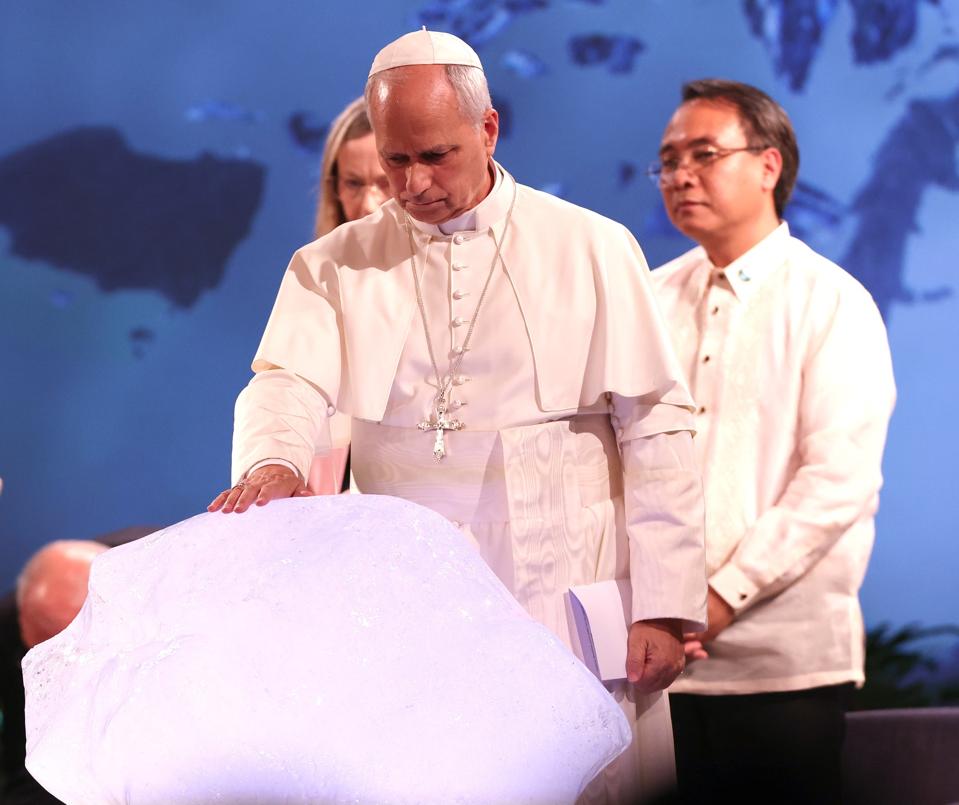Pope Leo XIV stood on stage at a climate conference in Rome last week and laid his right hand on a massive chunk of ice, blessing it.
This wasn’t just any ice. It had broken off the vast Greenland Ice Sheet, a key regulator of global climate that’s shrinking quickly as it melts due to climate change. The resulting rise in global sea levels could flood many tens of millions of homes, scientists warn.
Danish-Icelandic artist Olafur Eliasson transported the ice to the conference with the help of Danish geologist Minik Rosing as a stark reminder of how quickly the world’s glaciers are disappearing.
“It was striking to witness Pope Leo XIV bless a 20,000-year-old piece of Greenlandic glacial ice that stood on stage beside him at the Raising Hope Conference,” the artist wrote on Instagram. “We felt the presence of the fragile ice underscored the importance of recognizing that nature is not separate from humanity.”
The conference convened science, policy and faith leaders to address the climate crisis ahead of COP30, the United Nations Climate Change Conference in Brazil in November. Eliasson and Rosing collected the glacier fragment from the Nuup Kangerlua fjord, the world’s second largest fjord system.
A total loss of Greenland’s ice could cause the world’s oceans to rise by around 23 feet, according to the United Nations Intergovernmental Panel on Climate Change. That could have a devastating impact on coastal communities worldwide.
Eliasson wanted to call attention to this threat.
“As the ice releases meltwater into the ocean, it reminds us that our global relationship with ice sheets is existential,” the artist said. ”They link us to the past, shape our present climate, and, depending on our care or neglect, will determine our shared future.”
The artist often incorporates themes of nature into his work. For the Weather Project — a site-specific installation for London’s Tate Modern that explored the impact of meteorological events — he combined a semi-circular screen, a ceiling of mirrors and artificial mist to conjure the illusion of a sun and a giant indoor sunset.
Geologist Rosing, a professor at the University of Copenhagen, has extensively studied the composition of glaciers. He has gained particular attention for his research into glacial rock flour, a natural powder that flows as mud from under glaciers and has the potential to reduce global carbon dioxide in the atmosphere by trapping it.
Pope Leo XIV And The Environment
Pope Leo XIV, elected in May, addressed the environment and sustainability in the first days of his papacy. “We cannot separate our treatment of the Earth from our treatment of the poor,” he said in an early Vatican address. “They suffer together when we choose exploitation over responsibility.”
These words echoed his predecessor Pope Francis’ 2015 encyclical Laudato Si’, which stressed the urgency of the climate crisis and the need for “swift and unified global action” to protect what he called “our common home.”
“Water pollution particularly affects the poor who cannot buy bottled water,” the document reads, “and rises in the sea level mainly affect impoverished coastal populations who have nowhere else to go.”

